外研版七年级下册英语语法专题复习(含练习)教学内容
外研版七年级英语下册各模块语法知识汇总+专项练习

外研版七年级英语下册各模块语法知识汇总+专项练习M1 形容词性和名词性物主代词专项练物主代词分为两种:形容词性物主代词和名词性物主代词。
形容词性物主代词不能单独使用,后面必须跟名词,例如:We are doing our XXX(我们正在做家庭作业。
)名词性物主代词则具有名词的性质,可以单独使用,例如:My shirt is black。
but yours is white.(我的衬衫是黑色的,但你的是白色的。
)名词性物主代词也可以具有“形容词性物主代词+名词”的作用,例如:Whose comb is it。
It’s hers.(hers=her+comb)下面是物主代词的对照表:物主代词 | 形容词性 | 名词性 |我的 | my | XXX |你的 | your | yours |他的 | his | his |她的 | her | hers |它的 | its | its |我们的 | our | ours |你们的 | your | yours |他们的 | their | theirs |需要注意的是,名词性物主代词可指一件东西,也可指很多件东西,需要根据上下文来决定。
例如:选择填空:1.This is my teapot。
It’s not __________。
(your/ yours)2.My hairdryer is on the desk。
Where’s ____________?(her/ hers)3.___________ hairdryer is not on the table。
___________ is there。
(Her/ Mine)4.Whose calculator is it?It’s __________。
It’s __________ XXX)5.Are they ___________ (your/ yours) combs。
Yes。
they’re _________(our/ ours).用所给词的适当形式填空:1.That is not _________ kite。
(完整版)外研版七年级下册英语语法专题复习(含练习).docx

YOUWIN Education 优胜教育初中英语内部资料外研版|七年级下册重点知识点梳理法知点1.:物主代、情can 和方位介短2.:一般将来和一般去3.句型:特殊疑句、祈使句、感句和疑句词类1)物主代:表示所属关系的代(⋯属于的)数复数人称形容性物主代名性物主代形容性物主代名性物主代第一人称my mine our ours第二人称your yours your yourshis his第三人称her hers their Theirsits its形容性物主代和名性物主代的关系:形容性物主代:必和名在一起。
My father, your teacher...物主代名性物主代 :相当于与之相的形容性物主代+名。
This shirt is mine. =This is my shirt.(1)。
()1. Look at.A. himB. heC. his()2. I drive to the park every day.A. theyB. theirC. them()3.classroom is big.A. weB. usC. Our()4. I love.A. sheB. herC. hers()5. Do you know?()6. I am son.A. theyB. theirC. them()7. This is not _____ desk.. My desk is over there.A. IB. myC. me()8. -Can you spell _____ name, Harry? -Sorry.A. youB. yourC. yours()9. Tom and Jack are brothers. This is _____ room.A. theyB. themC. their()10. We are in the same class. _____ classroom is very nice.A. ourB. myC. ours()11. Mrs. Green is my teacher. I’m _____ student.A. heB. hisC. him()12. That ’s a cat. _____ name is Mimi.A. ItB. It ’ sC. Its( 2)用括号里的代的适当形式填空1, Mr Yang is _______(we) teacher.________(him) is from Beijing. _______(his)teaches______(our) English.2, Look,there is a cat._______(they) is Lily's.____(it) name is Mimi.3, Let______(I) tell ______(she) about_____(he) life at school.4, This is ______(they) room.Where is _____(our)?5, Don't use the eraser.______ is ______(me).6, The lady under the tree is ______(me) aunt._____(her) often sings with_____(she) husband2)情 can1.含:表达人或物的能力,能或会⋯2.特点:情can 没有人称和数的化,之后要加原形。
完整版)外研版七年级下册英语语法专题复习(含练习)

完整版)外研版七年级下册英语语法专题复习(含练习)XXX的初中英语内部资料,重点梳理了外研版七年级下册的语法知识点。
这些知识点包括词类、时态和句型。
在词类方面,重点介绍了物主代词、情态动词can和方位介词短语。
其中,物主代词表示所属关系,有单数和复数、形容性和名词性等不同形式。
形容性物主代词必须和名词在一起,而名词性物主代词相当于与之相对应的形容性物主代词+名词。
时态方面,重点介绍了一般将来时态和一般过去时态。
在句型方面,重点介绍了特殊疑问句、祈使句、感叹句和选择疑问句。
练题中,需要根据所给句子选择正确的物主代词形式。
11.Mrs。
Green is my teacher。
I am her student.12.That's a cat。
Its name is XXX.1.Mr。
Yang is our teacher。
He is from Beijing。
He teaches us English.2.Look。
there is a cat。
It is Lily's。
Its name is XXX.3.Let me tell her about my life at school.4.This is their room。
Where is ours?5.Don't use the eraser。
It is XXX.6.The lady under the tree is my aunt。
She often sings with her husband.2.XXX of a person or thing to do something.Can has no change in person or number and is followed by the base form of the verb.The negative form is cannot (formal) or can't (informal).XXX:Affirmative: subject + can + base form of verb + other words.XXX.Negative: subject + cannot/can't + base form of verb + other words.XXX.Interrogative: Can + subject + base form of verb + other words +?XXX swim well?Yes。
外研版七年级下册英语语法专题复习(含练习)

七下英语重要知识点梳理词类1)物主代词:表示所属关系的代词(…属于谁的)形容词性物主代词和名词性物主代词的关系:形容词性物主代词:必须和名词在一起。
My father, your teacher...物主代词名词性物主代词:相当于与之相对应的形容词性物主代词+名词。
This shirt is mine. =This is my shirt.练习(1)选择题。
()1. Look at . A. him B. he C. his()2. I drive to the park every day. A. they B. their C. them ()3. classroom is big. A. we B. us C. Our()4. I love . A. she B. her C. hers()5. Do you know ? A. I B. my C. me()6. I am son. A. they B. their C. them()7. This is not _____ desk.. My desk is over there. A. I B. my C. me()8. -Can you spell _____ name, Harry? -Sorry. A. you B. your C. yours ()9. Tom and Jack are brothers. This is _____ room. A. they B. them C. their ()10. We are in the same class. ____ classroom is very nice. A. our B. my C. ours()11. Mrs. Green is my teacher. I’m _____ student. A. he B. his C. him()12. That’s a cat. _____ name is Mimi.A. ItB. It’sC. Its(2)用括号里的代词的适当形式填空1, Mr Yang is _______(we) teacher.________(him) is from Beijing. _______(his) teaches______(our) English.2, Look,there is a cat._______(they) is Lily's.____(it) name is Mimi.3, Let______(I) tell ______(she) about_____(he) life at school.4, This is ______(they) room.Where is _____(our)?5, Don't use the eraser.______ is ______(me).6, The lady under the tree is ______(me) aunt._____(her) often sings with _____(she) husband2)情态动词can1.含义:表达人或物的能力,能或会…2.特点:情态动词can没有人称和数的变化,之后要加动词原形。
word完整版)新外研版七年级英语下册各单元语法总复习练习及答案

word完整版)新外研版七年级英语下册各单元语法总复习练习及答案Module 1语法:名词性物主代词在英语中,人称代词和物主代词是非常重要的。
人称代词分为第一人称、第二人称和第三人称。
物主代词分为形容词性物主代词和名词性物主代词。
一、选择填空1.这些是钢笔,那些是铅笔。
(that。
this。
those)2.XXX昨天病了。
这就是他缺席学校的原因。
(That,Those。
These)3.这些衬衫中哪些是XXX的?(These。
this。
that)4.这张桌子是我的,那张是她的。
(those。
this。
that)5.北京的地图比天津的地图好。
(this。
that。
these)6.他的名字是XXX。
她是一名厨师。
(He。
Her。
His) (She。
He。
His)7.我的姑妈是一名护士。
她工作非常努力。
(I,My,XXX) (She。
He。
Her)8.请给我指路。
(me。
I。
XXX)9.这些书不是我的。
它们可能是她的。
(my。
XXX。
I) (They。
It。
Its) (her。
hers。
your)10.让我告诉她如何做。
(I。
me。
mine) (her。
she。
hers)二、选择填空1.每个人都应该尽力而为。
(its。
ones。
his。
their)2.她是我的好朋友。
(She。
mine) (Her。
mine) (She。
my) (Hers。
my)1.What can you do。
I can lift this box。
but I can't lift that heavy chair.2.Can he read Chinese?——No。
he can't read Chinese。
but he can read.3.Can you stand in front of the door。
Then I can see you.4.Did XXX dishes。
Yes。
she did.5.I can see some spoons。
初中英语(外研社版)七年级下语法复习讲义
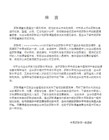
初中英语(外研社版) 七年级下语法复习讲义( Module 3-4) 1. 生词Plan revise test wife why foreign shopping early out on want cross useLife will paper ruler farm rain weather wind strong comfortable heat light free2. 重点句子,考点出处Module 31. We are going to listen to some music.2. Would you like to come?3. What’s Betty going to do on Saturday afternoon?4. I’m going to visit them in China because it’s my granddaughter’s birthday.5. I’m going to learn English because I want to make some American friends.6. They’re going to cross the Pacific Ocean and the Atlantic Ocean.Module 41. Everyone will study at home in the future.2. Everyone will send their homework to the teacher by email.3. And will they send their home work to the teacher by email?4. I’m not sure.5. Planes will be very large so flying will be very cheap.6. It will get warm at the North pole so the seas will be very rough.7. People will do many things on the Internet.8. Remember! You won’t understand every word.9. Try to understand the main idea with the words you know.10. Machines will do work in factories.11. Robots will clean the house, cook food, care the children and help old people.。
(完整版)外研版七年级英语下册知识点归纳及练习,推荐文档

疑问 Am I writing a letter? Is she/he listeningto music?
We are enjoying our trip.
We aren’t enjoying our trip.
Are we enjoying our trip?
They are talking to each other.
(listen ) tomusic.
9. It’s 5 o’clock now. We
(have)supper now
10.
Helen
(wash )clothes? Yes ,she is
2、句型转换: 1 They are doing housework .(分别改成一般疑问句和否定句) 2 The students are cleaning the classroom . ( 改一般疑问句并作肯定和否定回答)
规则 一般情况下,动词后直接加-ing 以不发音的 e 结尾的动词,去掉 e,再加-ing 以辅音字母+元音字母+辅音字母结尾的重 读闭音节,双写末尾辅音字母,然后加-ing
特殊变化 4、 现在进行时的否定和疑问形式结构
示例 working, buying, visiting, talking, saying taking, having, leaving, driving, writing
-最新外研版七年级下册各模块知识点汇总(含重点语法和配套练习)(解析版)
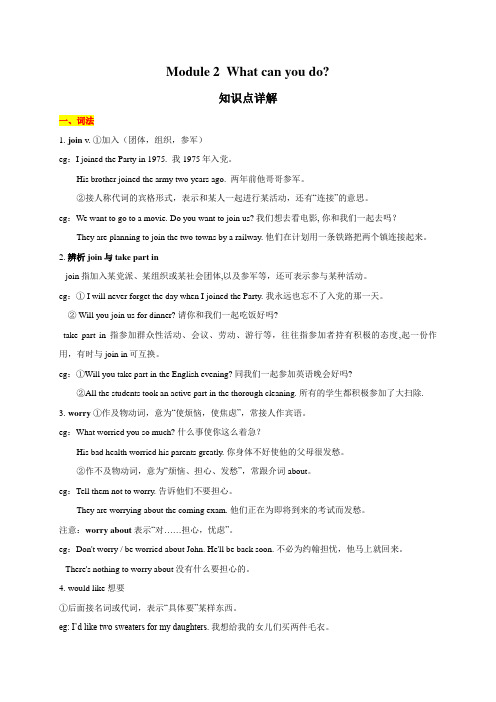
Module 2 What can you do?知识点详解一、词法1.join v. ①加入(团体,组织,参军)eg:I joined the Party in 1975. 我1975年入党。
His brother joined the army two years ago. 两年前他哥哥参军。
②接人称代词的宾格形式,表示和某人一起进行某活动,还有“连接”的意思。
eg:We want to go to a movie. Do you want to join us? 我们想去看电影, 你和我们一起去吗?They are planning to join the two towns by a railway. 他们在计划用一条铁路把两个镇连接起来。
2.辨析join与take part injoin指加入某党派、某组织或某社会团体,以及参军等,还可表示参与某种活动。
eg:① I will never forget the day when I joined the Party. 我永远也忘不了入党的那一天。
② Will you join us for dinner? 请你和我们一起吃饭好吗?take part in指参加群众性活动、会议、劳动、游行等,往往指参加者持有积极的态度,起一份作用,有时与join in可互换。
eg:①Will you take part in the English evening? 同我们一起参加英语晚会好吗?②All the students took an active part in the thorough cleaning. 所有的学生都积极参加了大扫除.3.worry①作及物动词,意为“使烦恼,使焦虑”,常接人作宾语。
eg:What worried you so much? 什么事使你这么着急?His bad health worried his parents greatly. 你身体不好使他的父母很发愁。
外研版七年级英语下册语法总结复习课程
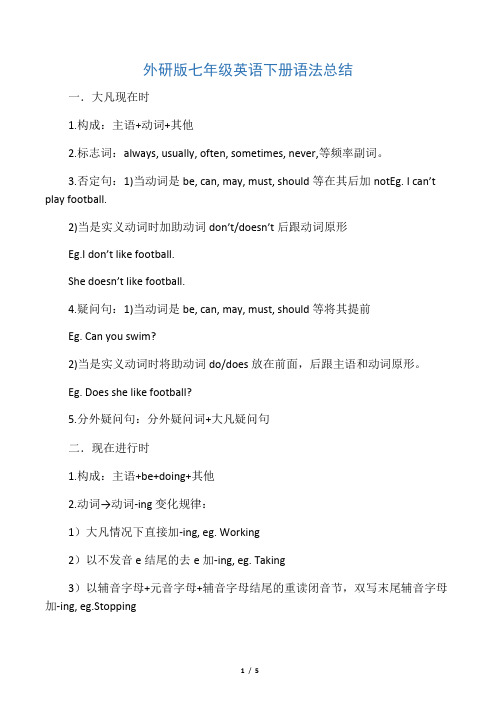
外研版七年级英语下册语法总结一.大凡现在时1.构成:主语+动词+其他2.标志词:always, usually, often, sometimes, never,等频率副词。
3.否定句:1)当动词是be, can, may, must, should等在其后加notEg. I can’t play football.2)当是实义动词时加助动词don’t/doesn’t后跟动词原形Eg.I don’t like football.She doesn’t like football.4.疑问句:1)当动词是be, can, may, must, should等将其提前Eg. Can you swim?2)当是实义动词时将助动词do/does放在前面,后跟主语和动词原形。
Eg. Does she like football?5.分外疑问句:分外疑问词+大凡疑问句二.现在进行时1.构成:主语+be+doing+其他2.动词→动词-ing变化规律:1)大凡情况下直接加-ing, eg. Working2)以不发音e结尾的去e加-ing, eg. Taking3)以辅音字母+元音字母+辅音字母结尾的重读闭音节,双写末尾辅音字母加-ing, eg.Stopping4)分外变化, lie—lying3.标志词:look, listen, now, at the moment, it’s…o’clock…4.否定句:be动词后加notEg. She is not listening to music.5.疑问句:将be动词提前Eg . Is she listening to music?6.分外疑问句:分外疑问词+大凡疑问句三.将来时1.构成:主语+be going to+动词原形will2.标志词:tomorrow, next day/month/year等表示将来的时间3.否定句:be动词后加not;will后加notEg. He is not going to have a piano lesson this weekend.He will not have a piano lesson this weekend.4.疑问句:将be动词提前;将will提前Eg. Is he going to have a piano lesson this weekend?Will he going to have a piano lesson this weekend?5.分外疑问句:分外疑问词+大凡疑问句四.过去时1.构成:主语+动词过去时+其他2.标志词:yesterday, just now, …ago, this morning, when I was young,last…等3.动词→动词过去式变化规律:1)大凡动词结尾加-ed, eg. Walk--walked2)以字母e结尾的动词加- d, eg. Live--lived3)以辅音字母加y结尾的变y为i加-ed, eg. Hurry—hurried4)以辅音字母+元音字母+辅音字母结尾的重读闭音节,双写末尾辅音字母加-ed, eg. Stop–stopped分外变化详见课本P1724.否定句:1)动词be过去式后直接加notEg. I was not in Chengdu last year.2)当是实义动词时,加助动词didn’t后跟动词原形Eg. I didn’t telephone my parents yesterday.5.疑问句:1)动词be过去式提前Eg. Were you in Chengdu last year?2)当是实义动词时将助动词did放在前面,后跟主语和动词原形Eg. Did you telephone my parents yesterday?6.分外疑问句:分外疑问词+大凡疑问句五.形容词、副词比较级,最高级1.形容词(1)在句子中做定语,大凡放在名词之前。
外研版七年级下册英语-语法复习
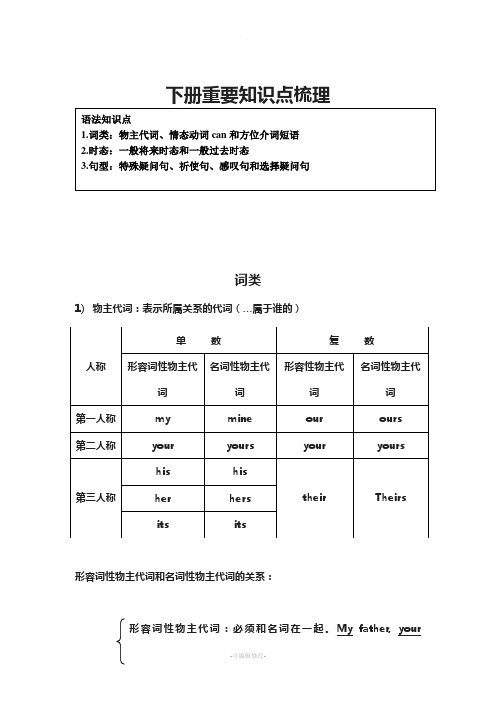
下册重要知识点梳理词类1) 物主代词:表示所属关系的代词(…属于谁的)形容词性物主代词和名词性物主代词的关系:形容词性物主代词:必须和名词在一起。
My father, yourteacher...物主代词名词性物主代词:相当于与之相对应的形容词性物主代词+名词。
This shirt is mine. =This is my shirt.练习(1)选择题。
()1. Look at .A. himB. heC. his()2. I drive to the park every day.A. theyB. theirC. them()3. classroom is big.A. weB. usC. Our()4. I love .A. sheB. herC. hers()5. Do you know ?A. IB. myC. me()6. I am son.A. theyB. theirC. them()7. This is not _____ desk.. My desk is over there.A. IB. myC. me()8. -Can you spell _____ name, Harry? -Sorry.A. youB. yourC. yours()9. Tom and Jack are brothers. This is _____ room.A. theyB. themC. their()10. We are in the same class. _____ classroom is very nice.A. ourB. myC. ours()11. Mrs. Green is my teacher. I’m _____ student.A. heB. hisC. him()12. That’s a cat. _____ name is Mimi.A. ItB. It’sC. Its(2)用括号里的代词的适当形式填空1, Mr Yang is _______(we) teacher.________(him) is from Beijing._______(his) teaches______(our) English.2, Look,there is a cat._______(they) is Lily's.____(it) name is Mimi. 3, Let______(I) tell ______(she) about_____(he) life at school.4, This is ______(they) room.Where is _____(our)?5, Don't use the eraser.______ is ______(me).6, The lady under the tree is ______(me) aunt._____(her) often sings with _____(she) husband2)情态动词can1.含义:表达人或物的能力,能或会…2.特点:情态动词can没有人称和数的变化,之后要加动词原形。
(word完整版)新外研版七年级英语下册各单元语法总复习练习及答案

新外研版七年级英语下册重点语法总复习Module 1语法:名词性物主代词一、选择填空1、These are pens and ________ are pencils. (that, this, those)2、Tom was sick yesterday. ________ is why he missed school. ( That, Those, These)3、Which of ______ shirts are Tom's ( These, this, that)4、This desk is mine, ______ is hers. ( those, this, that)5、The map of Beijing is better than ________ of Tianjing. (this, that, these)6、_______ (He, Her, His ) name is Jack. . _______ (She, He, His) is a cook.7、_______ (I,My,Mine)aunt is a nurse. ______ (She, He. Her) works very hard.8、Please show _______ (me, I, mine ) the way.9、The books aren't ________( my, mine, I ). ________ (They , It, Its ) may be _______(her, hers, your)10、Let ______(I, me, mine) tell _______(her, she, hers ) how to do it.二、选择填空1、Everyone should do ______ best.A. itsB. onesC. hisD. their2. ______ is a close friend of _______.A. She, mineB. Her, mine,C. She, myD. Hers, my3. You can not finish the work ________. Let ______ help you.A. youself, meB. yourself, mineC. yourselves, mineD. yourself, me4. _______ work is heavy, but ___________ is heavier than _________.A. Our, their, ourB. Our, theirs, oursC. Ours, theirs, ourD. Our, their, ours5. Please take good care of ________.A. youB. youselfC. yourselfD. myself6. Our teacher asked us to enjoy _________ during the summer holidays.A. usB. oursC. weD. ourselves7. He always thinks of others and never thinks of _________.A. himB. usC. hisD. himself8. Music makes ______ relaxing.A. usB. oursC. weD. he9. What's Tom's phone number _____ phone number is 81826753.A. He'sB. HisC. HeD. Her10. Where is your homework I can't find _______ anywhere.A.youB. yourC. yoursD. yourselfModule2语法:情态动词can肯定句结构:主语+can +动词原形+其他.否定句结构:主语+can’t(can not)+动词原形+其他.一般疑问句:把Can 提前肯定回答: Yes,主语+can.否定回答: No,主语+can’t.一、用can, can’t填空1. What ______ you do? I can lift this box, but I ______ lift that heavy chair.2. ______ he read Chinese? ——No, he ______ read Chinese, but he ______ read English.3. ______ you stand in front of the door? Then I ______ see you.4. ______ Penny wash the dishes? Yes, she ______ .5. I ______ see some spoons, but I ______ see any knives.Module3语法:一般将来时be going to+动词原形肯定句结构:主语+be going to +动词原形+其他.否定句结构:主语+be not going to +动词原形+其他.一般疑问句:be动词提前——Be +主语+going to +动词原形+其他?肯定回答:Yes,主语+be.否定回答:No,主语+be not.Module4语法:一般将来时will肯定句结构:主语+will +动词原形+其他.否定句结构:主语+will not +动词原形+其他.一般疑问句:will提前——Will +主语+动词原形+其他?肯定回答:Yes,主语+will.否定回答:No,主语+won’t(will not)注意:be going to 与will的区别1. 表示计划到某地去,谓语动词go与going重复,一般只说be going to +地点..2. be going to 表示自己打算做某事,计划做某事或有意做某事3. will 则表示对未来的猜测一、单项选择( ) 1. There __________ a meeting tomorrow afternoon.A. will be going toB. will going to beC. is going to beD. will go to be( ) 2. Charlie ________ here next month.A. isn't workingB. doesn't workingC. isn't going to workingD. won't work( ) 3. He ________ very busy this week, he ________ free next week.A. will be; isB. is; isC. will be; will beD. is; will be( ) 4. There ________ a dolphin show in the zoo tomorrow evening.A. wasB. is going to haveC. will haveD. is going to be( ) 5. -_____ you ______ free tomorrow? - No. I _____ free the day after tomorrow.A. Are; going to; willB. Are; going to be; willC. Are; going to; will beD. Are; going to be; will be( ) 6. Mother ________ me a nice present on my next birthday.A. will givesB. will giveC. givesD. give( ) 7. - Shall I buy a cup of tea for you? -________. (不,不要。
外研英语七年级下册重点语法复习(共50张PPT)

一、选择填空
(A )1.What ______ you do? I can lift this box, but I ______ lift that
heavy chair.
A. can, can’t B. can’t, can.
C. can, can.
A. Can, can’t B. Can, can.
C. Can, Can.
(A )4. She ______ see some cars, but she ______ see any buses.
A. can, can’t B. can’t, can.
C. can, can.
(C )5. What ______ Mike do at the party? He ______ dance.
用所给词的适当形式填空: 1.There _is__g_o_in_g__t_o_b_e_ (be) an American film next week. 2.They __a_r_e_g_o_i_n_g_t_o__fi_n_is_h_ (finish) the work this
afternoon. 3. _I_s__ Tom _g_o_in__g_t_o_p_l_a_y_ (play) football with us
特殊疑问句
特殊疑问句用于对不明确的人或事物提问,其句首
4. There __________ a meeting tomorrow afternoon.
A. will be going to
B. will going to be
C. is going to be
D. will go to be
新版外研社英语七年级下册各单元知识点汇总及习题练习

Module 1单词:whose pron.谁的lose v. (过去式lost)失去find v. (found ) 发现; 找到purple adj.紫色的; 紫红色的n.紫色;紫红色carefuladj.仔细的;认真的;小心的反义词:careless不认真的camera n.照相机leave v. (left )丢下; 遗忘strange adj.奇怪的search v.搜寻,搜索postv.邮寄sketch n.草图,素描choose v.选择describe v.描述detail n.细节,详述listn.清单,目录v.列表短语:1、Welcomeback to+地点名词欢迎回到...Welcome to+表示地点的名词欢迎来到某地Welcome to Beijing.Welcome +表示地点的副词Welcomehome! 欢迎回家(home/here/there是地点副词,前面不与介词连用。
)2、lostandfound 失物招领in the lost and found box 在失物招领箱里atthe lost andfoundoffice在失物招领处3、firstof all首先atfirst起初,首先(M8) firstly 首先secondly 其次4、hereis/are...这有..5、Thank you 的几种回答:Youarewelcome.不用谢That's allright.That'sOK.Notat all.It's my pleasure!/My pleasure.6、look at看(不一定看见)look是不及物动词,后面不直接加名词eg. lookat the blackboard看黑板see 看见seesb.do sth. 看到某人做过某事see sb. doingsth.看到某人正在做某事watch观看,仔细地看(比赛、电视等) watchTV看电视read 看、阅读(书、报纸、杂志等)read the book 读书7、becareful with注意.../小心(对待)...careful形容词careless carecarefully8、from nowon 从现在开始fromthenon 从那时开始9、Let me see. 让我想想。
2023年外研版七年级下册知识点归纳与练习

M11-M12知识点概要一、语法知识点总结:二、祈使句定义: 祈使句用来体现叮嘱、劝说、但愿、严禁、祈求或命令等。
特点: 无主语;无时态构造: 1.肯定句: 动词原形开头...例句.Pleas.b.careful..Wav.t.sa.goodbye.三、 2.否认句: Don’t+动词原形四、...例句:Don’te.. Don’.stan.to.close.五、感慨句定义: 体现一种较为强烈旳情感, 如喜悦、赞叹、惊讶、愤怒、厌恶等。
构造: What+强调或感慨旳部分+(句子旳主语或谓语动词)1.What+a/an+形容词+可数名词单数+(句子旳主语或谓语动词)例句: What a cute dog (it is)!2.What+形容词+可数名词复数+(句子旳主语或谓语动词例句: What beautiful flowers (they are)!3.What+形容词+不可数名词+(句子旳主语或谓语动词)例句: What delicious milk (it is)!注意:感慨句尚有另一种体现方式, 即How+形容词+句子主语+谓语动词例句: How cute the dog is! How beautiful the flowers they are!How delicious the milk is!六、选择疑问句定义: 在问句中提供两个或两个以上可选答案旳问句叫做选择疑问句。
选择疑问句旳两种或两种以上旳状况用or连接, 回答时不能用yes或no。
而是选择一种或两个答案回答。
例句: Is this by Strauss or Mozart? ---It’s by Strauss.Do you like apples or bananas? ---I like apples. 语法知识点练习:1......ge.of.th.bu.whe.i.stops.A.No.....B.Don’...C.Doesn’..D.Didn’t2.Please the door when you leave.A.clos...B.t.clos....C.close..D.closing3......polit.t.you.family.A.Bein...B.B....C.T.b..D.Been4......hand.t.sa.goodbye.It’.polit.i.China.A.Shakin...B.Shak...C.Wavin..D.Wave5.Pleas......quiet.Th.bab.i.sleeping.A.Bein...B.B....C.T.b..D.Bee.6......a.peopl.whe.yo.tal.t.them.A.Loo...B.Lookin....C.T.loo..D.Look.7.......th.classroo.afte.school..Ou.teache.said.A.Cleanin...B.T.clea....C.Clea..D.Cleans8......beautifu.cit.Vienn.is!A.Wha....B.Wha....C.Ho..D.Ho.a9......deliciou.mea.i.is!A.Wha....B.Wha....C.Ho..D.Ho.a10......bi.family!A.Wha....B.Wha....C.Ho..D.Ho.a11......nic.people!A.Wha....B.Wha....C.Ho..D.Ho.a12......ba.weather!A.Wha....B.Wha....C.Ho..D.Ho.a13......dangerou.th.animal.are!A.Wha....B.Wha....C.Ho..D.Ho.a14.Is this a Chinese book or English book? -----A.Yes.i.is...B.No.i.isn’t....C.Yes.i.does..D.A.Englis.book.15.D.yo.lik.roc.musi.o.classica.music.---.......A.Yes..do...B.No..don’t...C.Roc.musi..D.Yes..am.16.Doe.Mik.lik.basketball.---....... An.h.i..fa.o.Ya.Ming.A.Yes.h.does..B.No.h.doesn’t..C.basketbal...D.Bothuall.ea.noodle.o.hamburger.fo.lunch.---.....A.Yes.sh.does..B.No.sh.doesn’t..C.Yes.sh.is..D.Both.t.schoo.b.bu.o.b.bike.---..A.Yes..do...B.Yes..did...C.B.bik...D.Yes..am.其他知识点练习:1.Don’.stan.to.clos.....th.bi.dog.It’.dangerous.A.nea...B.a...C.t...D.from2..don’.lik.playin.basketbal..... .A.a.al...B.i.al...C.afte.al...D.o.all3.Don’t.again.Tom.--.......A.O...B.O.cours...C.Sorry..won’t...D.Wh.not.4.I.Indi.peopl.pu.thei.hand...... whe.the.mee.others.A.awa.. ..togethe...C.u... D.down5.It’.health.fo.yo.......exercis.tw.o.thre.time..week.A.t.d..B.di...C.d...D.doing6..lik.thi.piec.o.music.Wh.i.i...... ?A.b..B.i...C.o...D.for7..don’.lik.roc.music.becaus.it’.to......A.livel..B.quie..C.beautifu...D.noisy8.Th.Blu.Danub.goe.....Vienna.A.b...B.fo..C.ou..D.through9.M.brothe.i.......o.po.music.H.ofte.listen.t.i.a.home.A.fa..B.musicia..pose...D.singer10.Strauss’.walt..... famou.al.ove.Europe.A.fel...B.too...C.mad...D.kept。
最新外研版七年级下册各模块知识点汇总(含重点语法和配套练习)(解析版)
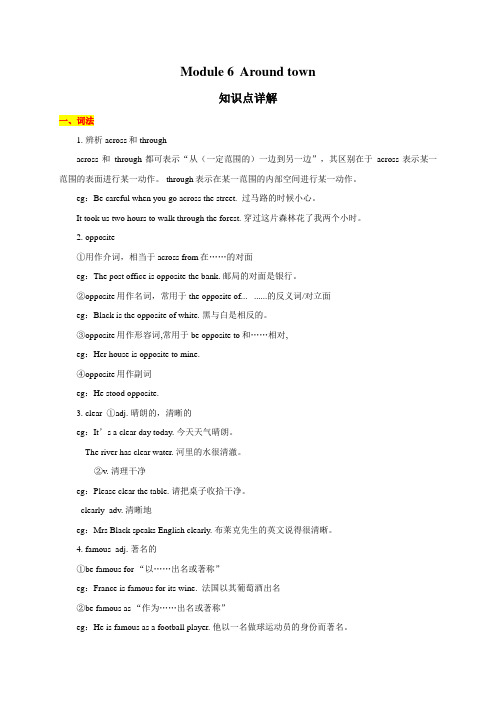
Module 6 Around town知识点详解一、词法1. 辨析across和throughacross和through都可表示“从(一定范围的)一边到另一边”,其区别在于across表示某一范围的表面进行某一动作。
through表示在某一范围的内部空间进行某一动作。
eg:Be careful when you go across the street. 过马路的时候小心。
It took us two hours to walk through the forest. 穿过这片森林花了我两个小时。
2. opposite①用作介词,相当于across from在……的对面eg:The post office is opposite the bank. 邮局的对面是银行。
②opposite用作名词,常用于the opposite of... ......的反义词/对立面eg:Black is the opposite of white. 黑与白是相反的。
③opposite用作形容词,常用于be opposite to和……相对,eg:Her house is opposite to mine.④opposite用作副词eg:He stood opposite.3. clear ①adj. 晴朗的,清晰的eg:It’s a clear day today. 今天天气晴朗。
The river has clear water. 河里的水很清澈。
②v. 清理干净eg:Please clear the table. 请把桌子收拾干净。
clearly adv. 清晰地eg:Mrs Black speaks English clearly. 布莱克先生的英文说得很清晰。
4. famous adj. 著名的①be famous for “以……出名或著称”eg:France is famous for its wine. 法国以其葡萄酒出名②be famous as “作为……出名或著称”eg:He is famous as a football player. 他以一名做球运动员的身份而著名。
- 1、下载文档前请自行甄别文档内容的完整性,平台不提供额外的编辑、内容补充、找答案等附加服务。
- 2、"仅部分预览"的文档,不可在线预览部分如存在完整性等问题,可反馈申请退款(可完整预览的文档不适用该条件!)。
- 3、如文档侵犯您的权益,请联系客服反馈,我们会尽快为您处理(人工客服工作时间:9:00-18:30)。
外研版七年级下册英语语法专题复习(含练习)外研版|七年级下册重点知识点梳理形容词性物主代词和名词性物主代词的关系:形容词性物主代词:必须和名词在一起。
My father, your teacher... 物主代词名词性物主代词:相当于与之相对应的形容词性物主代词+名词。
This shirt is mine. =This is my shirt.练习(1)选择题。
()1. Look at .A. himB. heC. his()2. I drive to the park every day.A. theyB. theirC. them()3. classroom is big.A. weB. usC. Our()4. I love .A. sheB. herC. hers()5. Do you know ?A. IB. myC. me()6. I am son.A. theyB. theirC. them()7. This is not _____ desk.. My desk is over there.A. IB. myC. me()8. -Can you spell _____ name, Harry? -Sorry.A. youB. yourC. yours()9. Tom and Jack are brothers. This is _____ room.A. theyB. themC. their()10. We are in the same class. _____ classroom is very nice.A. ourB. myC. ours()11. Mrs. Green is my teacher. I’m _____ student.A. heB. hisC. him()12. That’s a cat. _____ name is Mimi.A. ItB. It’sC. Its(2)用括号里的代词的适当形式填空1, Mr Yang is _______(we) teacher.________(him) is from Beijing. _______(his) teaches______(our) English.2, Look,there is a cat._______(they) is Lily's.____(it) name is Mimi.3, Let______(I) tell ______(she) about_____(he) life at school.4, This is ______(they) room.Where is _____(our)?5, Don't use the eraser.______ is ______(me).6, The lady under the tree is ______(me) aunt._____(her) often sings with_____(she) husband2)情态动词can1.含义:表达人或物的能力,能或会…2.特点:情态动词can没有人称和数的变化,之后要加动词原形。
3.否定形式:cannot(正式用法)=can’t(口语)4.句型结构:肯定句:主语 + 情态动词 + 动词原形 + 其他 + 。
She / They can swim well.否定句:主语 + 情态动词 + not + 动词原形 + 其他 + 。
She / They can not swim well.一般疑问句:情态动词 + 主语 + 动词原形 + 其他 + ?Can she / they swim well?Yes, she / they can. / No, she / they can’t.特殊疑问句:疑问词 + 情态动词 + 主语 + 动词原形 + 其他 + ?Why can she / they swim well?Who can swim well?练习:( ) 1) The sign on the wall means you stay away from the building.A. mustB. can’tC. shouldn't( ) 2) How many books you see on the desk?A. mayB. canC. should( )3) --- you see the sign over there? --- Sorry, I can’t.A. CanB. Can’tC. Sho uld4. I can run fast. I ________ ________ fast. (否定句)5. He can play basketball well. (一般疑问句)_______ he ______ basketball well?3)介词over在……Lingling sits between Tony and Daming. 玲玲坐在托尼和大明之间among 在三者或三者以上之间Miss Li is among lots of students. 李老师在许多同学之间注意:介词短语常和be动词连用。
时态1)一般将来时时间状语:in+一段时间;tomorrow;in the future; next+时间;this+时间(表示将来时间的状语)﹙Ⅰ﹚ be(is,am.are) going to 的用法。
含义:计划,打算做某事将来时句型结构:一般将来时 be going to+动词原形肯定句结构:主语+be going to +动词原形+其他.否定句结构:主语+be not going to +动词原形+其他.一般疑问句:be动词提前Be +主语+going to +动词原形+其他?肯定回答:Yes,主语+be.否定回答:No,主语+be not.注意:①表示计划到某地去,谓语动词go与going重复,一般只说be going to +地点.②come/go/arrive/leave等表示位置转移的动词可用于现在进行表将来。
Eg:I am going to London next year.She is going to check her email.Look! The bus is coming.﹙Ⅱ﹚由shall和will引导的一般将来时含义:将会…特点:助动词shall和will没有人称和数的变化,之后要加动词原形。
shall在一般将来时中,一般用于第一人称之后。
例如:I/We shall have an English lesson.我们将有一节英语课。
否定形式:shall not=shan′t will not=won′t将来时句型结构:肯定句:主语+shall/will+do否定句:主语+shall/will+not+do(will not 可缩写成won’t)一般疑问句:shall/will+主语+ do特殊疑问句:疑问词+ shall/will+主语+do2)一般过去时1.一般过去时表示过去某个时间发生的动作或存在的状态,常和表示过去的时间状语连用。
一般过去时也表示过去经常或反复发生的动作。
2.标志性时间状语:yesterday(昨天), last week(上周), last month(上个月), last year(去年), two months ago(两个月前), the day before yesterday (前天),in 1990 (在1990年), in those days (在那些日子里)等表示过去的时间状语连用。
3.动词结构:V-ed动词过去式变化规则:1.一般在动词末尾加-ed,如:pull-pulled, cook-cooked2.结尾是e加d,如:taste-tasted3.末尾是辅音字母加一个元音字母和一个辅音字母的重读闭音节,应双写末尾的辅音字母,再加-ed,如:stop-stopped4.以“辅音字母+y”结尾的,变y为i,再加-ed,如:study-studied5.不规则动词过去式:lose(丢失) ----lostmake(制造) ----made mean(意思) ----meant meet(见) ----metpay(付) ----paid say(说) ----saidsell(卖) ----sold send(送)----sent sit(坐) ----satsleep(睡) ----slept smell(嗅) ----smelt spell(拼写) ----spelt spend(度过) ----spentstand(站) ----stoodteach(教) ----taughttell(告诉) ----toldwin(赢) ----wonthink(想) ----thoughtunderstand(理解) ----understood begin(开始) ----beganblow(吹) ----blewbreak(打破) ----brokechoose(选择) ----chosedo(做) ----diddraw(画) ----drew drink(喝) ----drank drive(驾驶) ----drove eat(吃) ----atefall(落下) ----fell fly(飞) ----flew forget(忘) ----forgot give(给) ----gavego(去) ----went grow(成长) ----grew know(知道) ----knew lie(躺) ----lay----lain ring(按铃) ----rang write(写) ----wrote ride(骑) ----rodesee(看见)----sawshow(出示) ----showed wake(弄醒) ----wokesing(唱) ----sangspeak(讲话) ----spoke steal(偷) ----stole wear(穿) ----woreswim(泳) ----swamtake(拿) ----tookthrow(扔) ----threw become(成为) ----became come(来) ----camerun(跑) ----ran4. 句式变化规则:Be动词在一般过去时中的变化:(1)am 和is在一般过去时中变为was。
(was not=wasn't)(2)are在一般过去时中变为were。
(were not=weren't)(3)带有was或were的句子,其否定、疑问的变化和is, am, are一样,即否定句在was或were后加not,一般疑问句把was或were调到句首。
